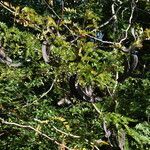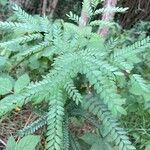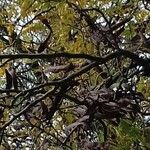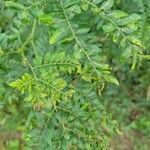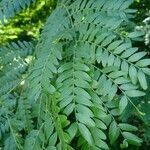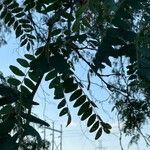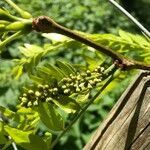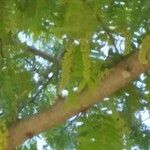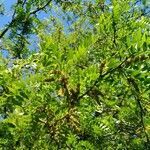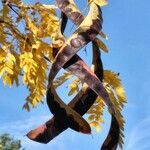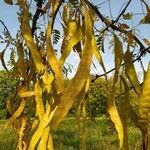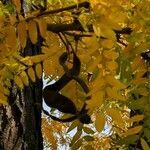Tree, usually armed with spines to 18 cm long; trunks and main branches often beset with a mass of spines. Leaves usually bipinnate and alternate on new growth and simply pinnate and fascicled from spurs on older wood; margins of leaflets conspicuously crenate or crenulate-denticulate. Bipinnate leaves mostly with 2-10 pairs of pinnae; leaflets 5-13 pairs per pinna, elliptic-oblong, mostly 1.3-2 cm long. Pinnate leaves in fascicles of 3-6, mostly with 10-16 pairs of leaflets; leaflets 1.5-3.8 cm long. Flowers greenish, in axillary, slender, drooping racemes. Staminate inflorescences with crowded subsessile to shortly pedicellate flowers; carpellate and perfect inflorescences with fewer pedicellate flowers. Stamens 5-7. Ovary densely pubescent. Pod oblong, often somewhat falcate, 15-40 cm long, 2.5-3.5 cm wide, indehiscent, with many seeds embedded in a pulpy tissue; valves reddish brown, often twisted or contorted at maturity.
A deciduous tree. It grows to a height of 30 m and spreads to 5-20 m across. The trunk can be 90 cm across. The stem is erect and straight. It has thorny branches and a broad crown. The leaves are glossy dark green and sword shaped. They have 10 to 12 pairs of leaflets. Some forms have more compound leaves. The leaflets have saw like teeth around the edge. The male and female flowers are on the same tree but separate. The flowers are small and greenish yellow. They occur in clusters. Flowers are pollinated by insects. The fruit are brown, curved and twisted pods. They are 45 cm long and burst open naturally. The seeds are oval and 8 mm long. The pods fall without opening. There are several named varieties.
Tree to 20 or even 40 m; lvs with 9–14 pairs of lfls or 4–7 pairs of pinnae; lfls oblong-lanceolate, obscurely crenate, 2–4 cm on pinnate lvs, 1–2 cm on bipinnate ones; petioles pubescent; staminate racemes 3–7 cm, densely many-fld; fertile racemes loose, with fewer, more evidently pedicellate, pistillate or perfect fls; pods 15–40 × 3–4 cm, dark brown, firm, pubescent when young, the seeds ca 2 cm apart and separated by sweetish pulp; 2n=28. Rich moist woods; Pa. to Tenn. and w. Fla., w. to s. Minn., se. S.D. and Tex., and widely cult. elsewhere. May. G. ×texana Sarg., with pods 10–15 cm, lacking pulp, is a rare hybrid with no. 2 [Gleditsia aquatica Marshall].
Tree or shrub, usually armed with stout straight or branched thorns. Leaves usually simply pinnate and bipinnate on the same shoot; leaflets 1-3.5 cm long, 0.4-0.9 cm wide, usually appressed-pubescent at least along the midrib, margins conspicuously crenate or crenulate-denticulate. Flowers greenish, small, in axillary, slender, drooping racemes. Calyx campanulate, the lobes slightly shorter than the petals. Stamens 3-10, filaments free. Ovary densely pubescent. Pods 15-30 cm long, 2.5-3.5 cm wide, usually slightly falcate but often twisting with age, indehiscent, compressed, with many seeds embedded in a puply tissue.
Spreading tree or shrub, (3-)15-20 m high; armed with stout straight or branched thorns, 50-100 mm long; roots from suckers. Leaves bright green, pinnate or bipinnate, 120-200 mm long. Leaflets oblong to widely lance-shaped, minutely toothed, 10-20 mm long. Inflorescences with male and female flowers borne separately in long narrow sprays, 30-60 mm long. Flowers small, yellowish green. Calyx campanulate, 3-5 lobes, subequal. Flowering time Oct., Nov. Pod dark reddish brown, flattened, up to 400 x 30 mm, compressed, leathery, indehiscent. Seeds many, embedded in a sweetish pulp.
Tree or shrub, up to 6 m high; armed with stout or branched spines. Leaves usually simply pinnate and bipinnate on same shoot; leaflets 10-35 mm long, with crenate or crenulate-denticulate margins. Flowers: in a slender, drooping, axillary raceme; flowers small, greenish; Sep., Oct. Pods 150-300 mm long, slightly falcate, twisting with age.
It is very similar to the last (Gleditsia triacanthos) and, like that, has branched spines; its pods, however, are 20–40 cm. long.
